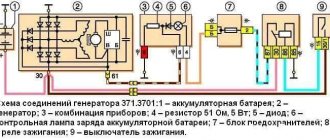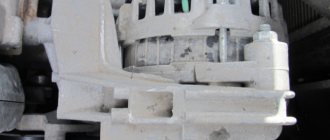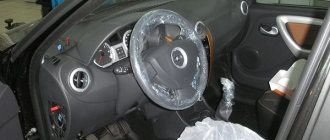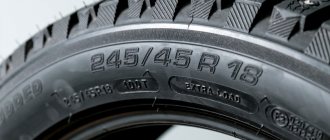Modern cars are slightly different from older vehicles in terms of appearance and functionality. Such machines have evolved into real computers, but there are devices and parts that remain mandatory for both old and new machines. We are talking about the main parts, additional temperature and light indicators, and also limit switches. Now you can figure out what a limit switch is and where it is located in cars of different generations.
Connection procedure and specifics
Connection diagram
Although the limit microswitch itself is designed quite simply, it can be used in technological equipment rich in electronics. It follows from this that it should be connected by an experienced specialist who is well versed in switching circuits of electronic components.
A typical example of such a connection is the installation of a mechanical switch in a typical 3D printer, during the operation of which it is necessary to fix the extreme position of the carriage. The mounted switch has 3 contacts with the following designations: COM, NO, NC. In the open state, the first and third terminals have a voltage of +5 Volts (while the second contact is reliably grounded). When the movable carriage reaches its extreme position, a connection appears between COM and NC, after which it locks and rebounds by approximately 2 mm.
Such a sensor is connected via two conductors in red and black insulation. When installing another type of switch (with an indicator), a more complex circuit is used, in which another conductor is provided - in green insulation. When the push-type microswitches in the printers are triggered, the LED lights up and a characteristic click is heard. Its connector, located on the switching board, has special designations:
- the red wire is marked as V (+5 Volts) and is used to connect the corresponding voltage;
- the black conductor is connected to point G (or ground);
- The green bus is set to S (signal).
The same signs are also present on the optical limit switch connector, which more accurately fixes the position of the carriage.
It works completely silently, reaching the extreme position is accompanied by LED indication. Its disadvantages include the possibility of failures due to heavy dust or exposure to direct sunlight.
Connection rules
Despite the fairly simple design of limit switches, they are used in electrical equipment where there are complex electrical circuits. As a result, they must be connected by specialists who know how to work with circuit diagrams for connecting limit switches. The sensor is connected with two wires, red and black. The first is under voltage, the second is without it. They are installed in the circuit as indicated in the diagram.
When the device is triggered, a click is created. The indicator type of switch is connected in the same way as a regular mechanical one. There is also a third green wire. The LED will indicate that the switch has tripped with a click.
Note! Operation failure may occur due to dust and sunlight. If the optical pair works, the light-emitting diode turns on.
Limit switch - device design and principle of operation
A limit switch is used to control and limit the movement of various mechanisms.
It must have the following characteristics: reliability of operation, safety for people and devices, high mean time between failures.
There are a large number of varieties of these switches: mechanical, magnetic, inductive. Each group is divided into subgroups. It all depends on where this or that device will be used.
Purpose of limit switch
Switching of 220V AC electrical circuits can be carried out using limit switches.
The action of the devices and their operation is determined by the contact contact of the end parts of the moving elements of the pneumatic drive, consisting of two-position pipeline fittings.
In addition, they can be used as limit switches that act as a position sensor in other devices, in systems used in industrial automation.
Design and operation of the switch KV-1, KV-2
The operating principle of the KV-1 (single-position, two-channel), KV-2 (two-position, single-channel) linear movement devices - limit switches is to use a permanent magnet printed circuit board with two reed switches, they are used as the main elements that switch the electrical circuit.
In addition to the board in the “limit switch” housing, the limit switch device contains a terminal block; in the main (first) housing there are two blind holes in which the rod goes; for KV-02 there are 2 rods. A permanent magnet, a magnetic circuit and a return spring are attached to the rod.
The action of the rod is reciprocating, with its help the magnet moves and closes and opens the contacts.
Rice. No. 1. Photo of the limit switch KV-01, KV-02.
Rice. No. 3. Drawing of the KV-1 limit switch indicating the overall and installation dimensions of the KV-01 and the location in the cable entry structure.
Limit switch KV-04
The design of the KV-04 (two-position, single-channel, rotary) is in principle similar to previous devices. Unlike a single-position switch, it is complicated by the presence of a rotary lever, with which you can adjust the angle of rotation of the axis clockwise and counterclockwise. Thus, the reed switches are switched.
Rice. No. 4. Drawing with dimensions of switch KV-04
The adjustment occurs by changing the cams located on the washer; they act on the levers, when turned, the magnet moves, switching the reed switch.
Fig. No. 5. Schematic electrical diagram for connecting the KV-04 limit switch.
Rice. No. 6. Photo limit switch KV-04.
Non-contact limit switches
Limit or, as they are also called, travel switches are non-contact, they operate based on the use of electromagnetic relays, as well as on the use of logical elements, the operation occurs without influence from the moving part of the device.
Non-contact limit switches are divided into two main types according to the principle of operation and the effect on the sensitive element:
- Mechanical impact.
- Parametric influence, due to changes in the physical parameters of the converter.
Parametric switches are divided into the following types:
- Inductive.
- Capacitive.
- Optical.
The connection of such devices is based on the use of a 2- and 3-wire circuit. In the case of a 3-wire circuit, power comes through a special wire.
Rice. No. 7. Contactless limit switches (sensors).
Non-contact limit switches are subject to increased requirements for operational reliability, because such devices have to operate under difficult conditions.
The location of these devices is in the working area of machines and assemblies, where they may be exposed to significant high temperatures, may be subject to shock and operate under the influence of strong vibration.
They can also be under the influence of a strong magnetic field, they can be affected by various, including aggressive liquids and contaminants.
Particularly important is the high requirement for increased switching frequencies, especially when used in complex technologies, for example, machine lines operating in automatic mode, complex transport systems, metallurgy and foundries.
Types and Applications
The end cap can be protective or functional. The first is used to activate downward movement, and the second is used to regularly turn lights or similar objects on and off. Both varieties are actively used in construction, mechanical engineering, metallurgy and industrial automation.
It is also worth pointing out that it can be roller, lever, float and push-button. There are microswitches, the scope of which is electronics and household appliances.
Scope of equipment application
Mechanical
Mechanical or contact conductors are those that operate at the moment of direct action on a pin with a button, wheel or lever. Provides a control signal with a warning. A serious disadvantage of each of these varieties is burning with contact sticking during repeated switching on and off.
You may be interested in this Designation of machines
The mechanical type is push-button, roller and lever. It is used in production and metallurgical workshops, machinery and construction. Equipped with a rubber seal and make/break contacts.
The mechanical variety is one of the most common
Push-button
Push-button conductors are used to turn on lights or other electrical devices by pressing a button. The impact can be either by pressing a button or by pressing an extended rod. Installing them takes a short time.
Roller
Switches are electromechanical devices designed to control objects. Widely distributed in industrial and domestic spheres. Such devices operate not due to an electric pulse, but due to mechanical action on the roller. At the moment of effort, the contact closes or opens, and a control or signaling type signal is sent. Similar products are used in metallurgy, construction and mechanical engineering.
Note! Most often, they are equipped with making and breaking contacts and rubber seals.
Roller variety as a simply plug-in model
Lever
Limit switches operating due to an actuator or door. They have a similar operating principle as push-button models. The main difference is the presence of a lever connected to the moving part of the contacts. It is worth pointing out that float and slider models work in a similar way.
Contactless
Limit switches that are triggered when an object approaches in a certain area. Created as opposed to the mechanical type and refers to perfect models. They operate thanks to transistor switches with low resistance. Non-contact models are capacitive, inductive, optical and ultrasonic.
Contactless modern model
Capacitive
End switches that interact with people. At the moment a person approaches, an electrical capacitance is created, thanks to which the multivibrator operates. The closer the person, the greater the capacitance and the lower the pulse frequency. This element has great sensitivity.
Note! The main function lies on the plate tightly attached to the capacitor part.
Inductive
Electronic proximity switches that respond to the moment the magnet moves. Depending on the equipment of the metal or non-magnetic core in the sensor, electrical impulses are generated, thanks to which the key is closed or opened.
The inductive model as one of the classic
Optical
Limit switches equipped with an infrared LED and a special transistor that pick up the signal. The phototransistor works no matter what the lighting is. When the LED beam is interrupted, the photocell closes. This turns off the actuator where it is connected.
You may be interested in the principle of operation of a constant voltage generator
Limit switches equipped with an infrared LED and a special transistor that detect the phototransistor.
Ultrasonic
Limit switches equipped with quartz sound emitting elements. Volumetric motion sensors are also used. The amplitude of the sound changes when quartz sound elements appear within the operating radius.
Easy to work with ultrasonic model
Magnetic
Conductors that are activated when a certain spatial point approaches. They are tuned to a magnet, which is part of the design of the moving mechanism. They have one or more ferromagnetic contacts. When the magnet approaches, the contacts close, and a signal about this is sent to the control circuit. The main advantage of such a device is the complete absence of mechanical action and a noticeable increase in service life. Each magnetic limit switch is created in a glass or plastic housing.
Note! It has miniature dimensions.
Automotive
Limit switches used in signaling with lighting. They belong to the mechanical model, since they have the same operating principle. By design, they have one output with a connected positive potential and a negative terminal - a housing that is clamped to a metal body. In this case, it is necessary that the limit switches be protected from paint.
Spindle
Limit switches limiting the movement mechanism, used as a limit switch. Can be used where there is shaft rotation. Thanks to the rotating mechanisms, the contact group of the input limiter, rotating shaft or cyclic control limit switch is switched.
Spindle model as the easiest to work
Pneumatic
Conductors that respond to system pressure, which stops the supply of air with any gas. Devices that stop compressed air or other gas by pressing a control button or lever. At the same time, there are varieties that are triggered when a specific system pressure is reached.
Kinds
There are one-, two- and three-pole devices. The first two are designed for a load of 10-25 A, the permissible voltage is 220V. Three-pole devices can withstand a voltage of 380 V, while the load is slightly reduced, it should not be more than 15 A.
Open, closed and completely sealed bags are available. Open type switches do not have a protective shell. These packagers are used to switch connections at a safe voltage and only indoors. Closed devices are equipped with a housing made of plastic or metal. The terminals of these devices are protected from touch, and the device itself is perfectly protected from dirt and dust. Closed models can be installed outside the panel cabinet.
Sealed electrical appliances are enclosed in a non-flammable, shockproof, hermetically sealed plastic shell. The high level of protection allows the devices to be installed in open spaces. Some models are equipped with a transparent window through which you can monitor the status of the contacts.
The popularity of packaged devices is gradually declining, but the production of such electrical appliances has not ceased. Reliability, availability, and speed of operation help baggers still remain a sought-after product.
Problems with limit switches
Another problem may be the wrong location for installing these parts.
Also, door ends can quickly become corroded and oxidized. Through the filament of the interior light, a positive signal is supplied to the limit switch contact, or the alarm system pulls the input to the positive potential to avoid false alarms. In this case, when condensation gets on the contacts, a low degree of electric current leaks, which will not be enough to trigger the alarm or light the interior lamp. But for such an electrochemical reaction as oxidation-decomposition, metal is enough. After some time, such a limit switch will not work.
Popular publications
How to connect a limit switch
Before connecting the wires of devices, it is necessary to turn off the electricity by making a switch in the panel. Limit switch installation requires careful adjustment of the response.
To install and connect the device, you need to fix the door using four self-tapping screws so that when closed it presses on the limit switch key, and when open the button is released. Connect the electrical circuits of the switch through the terminal block to a current of 220 V.
The limit switch in the electrical circuit should be the last element before the supply wire.
For the front door
The limit switch on the front door is designed to ensure the functioning of the alarm system and activate the light in the apartment. It is more advisable to install contactless sensors, since they take up little space and are quite reliable in operation.
Before installation, the position of the door and the limit switch should be taken into account. To connect the electrical circuit device, it must be done on a fireproof base for fire protection purposes. Installation and adjustment of the switch should be done with a certified tool.
For wardrobe
The purpose of installing limit switches is to provide automatic lighting when the door is opened. First you need to lay electrical wiring to the cabinet. At the ends of sliding doors, it is required to install a door mechanical switch with a voltage of 220 volts. All wires must be laid in protected trays. Then the installation of the lamp and end strips are marked. After installation, the wires are connected and the operation of the limit switches is adjusted.
For sliding doors
For sliding doors, the installation of a limit switch is similar to that for furniture, but an ultrasonic sensor should be used.
For swing doors
For swing doors you need to use a mechanical push-button switch type 4313WD. Wires to the installation site are laid in trays. Setting up the operation of the switch with your own hands must be done carefully without damaging it, since the working stroke of the rod is 3.5 mm.
For gates
Roller mechanical limit switches are used to automatically open and close gates. Installation is possible only on sliding gates, since they have less play in the mechanical part than swing gates. At the ends of the gate it is necessary to install end gates, which will be connected to the opening drive motor and to the starter.
When installing switch devices on gates, the conductors are supplied to the electric motor in a corrugated pipe, and the switch is installed in a moisture-resistant housing.
For auto
The installation of limit switches in the car is necessary for the functioning of the alarm and lighting. A simple push-button switch is used on the hood and trunk doors. For interior doors - contactless. After connecting the limit switches for the car, you should adjust the sensitivity of the security system.
Loading …
End switches - what lies behind this name
When a car door or hood is opened, an alarm is installed, small parts are replaced, everyone always remembers the limit switches. For owners of Niva, Logan, Chevrolet, Lanos, Logan, Kalina or others, they look different. The limit switches may look like ordinary switches, which are located on the door, trunk and other necessary points, or they may be hidden inside the door - this type of arrangement is used for Kalina cars, because there the limit switches are located in the door locks. This arrangement is less convenient than the external one, but is also more reliable. Limit switches are small systems that act as switches and are practically impossible to do without.
Magnetic devices
Reed switches
Limit switches that respond to a magnetic field are assembled on the basis of a reed switch. A reed switch is a device that contains a pair, or more, of contacts made of a special ferromagnetic alloy.
When a magnet is brought near, they close (or open). The advantage of this design is the absence of mechanical contact, which significantly increases the service life of such a limit switch.
To install it, it is important not to forget about the magnet, since there will be no reaction to ordinary iron. The scope of application of this model is very wide. Essentially, this is a microswitch that can be discreetly placed anywhere
For example, it can be connected to a car alarm to discourage those who like to drain gasoline
Essentially, it's a microswitch that can be discreetly placed anywhere. For example, it can be connected to a car alarm to discourage those who like to drain gasoline.
The operating principle is simple. When the door is closed, the magnetic field acts on the microswitch. The circuit is closed, everything is fine. When you open the gas tank cap, the magnet comes off, the contact breaks and the alarm goes off.
Inductive models
As a rule, these are also not separate devices, but blocks: one housing can contain several pairs of contacts. The sensors have different designs: fastening with bolts, nuts, or glue. The sizes are also very different: from large to microswitches. Such limit switches require supply voltage. They are used as motion limiters for various mechanisms.
A limit switch of this type replaced mechanical models quite a long time ago. It is more convenient because it does not require direct touching. In addition, having an inductance coil in its design, such a limit switch reacts to metal, which means there is no need to install a separate magnet.
As you can see, limit switches have a fairly wide range of models. For the most part, these are blocks containing contacts in various designs, which makes the limit switches more versatile. Large, strong housings are required for work under heavy mechanical loads. Microswitches are widely used both at home and in industry. Everyone can find the right model for themselves.
Checking the door switch
When the rod is recessed, the contacts are open. First of all, we check the serviceability of the sensors by opening all the car doors one by one.
Check with a multimeter. We connect a multimeter to the limit switch terminals in ohmmeter mode and check the closure of the sensor contacts (the contacts must be closed, the resistance is close to zero). We press the sensor rod and check the measurements (the contacts must be open - the resistance tends to infinity).
Let us remind you that in some cases (for example, in the cold season) limit switches may work intermittently. For Lada Vesta, Grant and Kalina 2 you can use this solution, and for Priora this.
Limit switch markings
Microswitches and microswitches, regardless of their characteristics, have specific markings. After decoding it, it is possible to obtain all the information about each limit switch model. If an entry like “VU222M” is found on it, this indicates a switch of the corresponding series. As an example, let’s decipher the labeling of a widely used product brand VP 15M4221-54U2. It means that its design has one moving element of the 15 series, as well as one make and break contact.
Limit switch markings
All switching elements in this series are controlled by a pusher with a roller built into the housing.
The degree of protection on the drive side of the structure corresponds to IP54, and the “U” symbol means climatic version. The following number 2 is the category of placement of the product, which corresponds to TU U 31.2-25019584-005.
Design features of a limit switch with a roller
A design of this type is one of the options for implementing a push-button type, only with a modified button. Installing a roller can significantly expand the functionality of the device. If the button can be pressed only in the axial direction, then the roller will respond to any impact - axial or tangential, the main thing is that the vector of this impact is in the plane of rotation.
Limit switch device
The spring-loaded rod on which the roller is mounted is a movable element on which two pairs of contacts are installed - normally closed and normally open. When pressed, one pair opens and the other closes. This design is usually called the plunger type KV.
Limit switch type plunger-roller
It is used primarily on lifting mechanisms and devices with vertical movement of moving parts. For horizontal elements it is used to a limited extent, only when the accuracy of the impact and limited effort are guaranteed.
There are lever roller designs. The roller is mounted on a rotary lever, which, when turning, closes the contact group inside the housing. This design is convenient in mechanisms where it is impossible to precisely adjust the force and range of contact with a moving element due to high inertia, vibration, and uneven movement.
Lever limit switch
The risk of destruction of such a device due to too sharp or intense contact is much less than when using a plunger-type limit switch. They are usually installed on massive and large moving elements with increased inertia - elevators, escalators, trolleys, mine elevators, sliding gates of hangars, etc. Sometimes such structures are called limit switches, since they have the ability to be triggered by moving elements passing without stopping.
There are KV models with adjustable lever length. They allow the length of the roller support to be changed, which expands the capabilities and scope of the device.
Roller limit switch with adjustable lever
There are also designs where a lever is added as an additional element to increase safety. If you unscrew it, the HF takes on the appearance of a regular push-button device. Most microswitches have this design.
Microswitches
Impulse relays
Controlling lighting using pulse relays is a completely different approach than those described above. Pulse relays are often used where it is necessary to control light from two or more places (to infinity), not limited by the load of the lines and the area of the premises. The main difference is that control by this method occurs using push-button switches (buttons) and a pulse relay mounted on a DIN rail in the electrical panel. There are also relays that can be installed in junction boxes, socket boxes or lamps, but these are used much less frequently.
The operating principle of a pulse (bistable) relay is quite simple. When voltage is applied to the relay coil (by pressing one of the control buttons), a pulse occurs, which closes the contact and opens after a second pulse. This is achieved by the fact that in such relays the armature has two stable positions, which change with each new short-term power supply to the coil and remain motionless after there are no contacts (i.e. the relay does not require constant power to hold the contacts).
As you can see in the diagram, to connect the relay you need to run two cables to the electrical panel where the relay will be installed. A cable from a group of buttons and a cable from a group of lamps, which makes it easy to change in the future to any other method of lighting control when needed.
In the future, new lighting schemes will definitely be added, following new technologies and trends.
blog comments powered by DISQUS back to top
Wiring check
Instructions for cars of the B0 assembly line (XRAY, Largus, Nissan Almera, Renault Duster, Sandero). Remove the limit switch and set the multimeter to voltmeter mode. We measure the voltage at the contacts of the block with the wires:
- If there is no voltage, the circuit of the interior lamp lamp or the lamp itself is faulty.
- if the voltage is significantly less than 12 V, the wire connecting the sensor to ground is probably damaged.
We set the multimeter to ohmmeter mode, connect one probe to ground (body), and the other to the terminal of the block with the black wire. The resistance should be close to zero. If the resistance is high and tends to infinity, the connection between the wire and the body is probably damaged by corrosion or the wire is damaged (treat the connection with a product to protect electrical contacts). If the fault cannot be resolved in this way, it is necessary to remove the interior trim from the pillar, find and fix the fault.
Areas of application
Each type of limit switch is typically used in various fields of activity. By application they can be divided into:
- Protective, which are installed to protect the mechanism or personnel from ill-considered actions. For example, a cage lowering people into a mine will not begin to move until all its doors are closed, thereby ensuring the safety of the miners.
- Functional. They regularly turn lights or other electrical mechanisms on or off. The most obvious example of such a device, known to everyone, is the turning on of the light in the refrigerator when the door is opened.
In general, the use of limit switches depends on the possibility of the mechanism for its use and the imagination of the designer. People don’t even realize how often they have to deal with this electrical mechanism:
- in everyday life and household appliances;
- in the automobile and in the automotive industry;
- in furniture products;
- in production to solve a wide variety of problems.
How to find door switches?
If you don’t know where the door switch is located, then you should start searching for them with a manufactured control or “tseshka”. Signals are removed from the door limit switches - the button principle. This is done in order to protect the car alarm system around the perimeter of the car. When the door is open, the limit switch is not clamped, it is free, and a plus or minus hangs on its wire. But this happens extremely rarely.
First of all, you need to find a wire whose polarity changes and either positive or negative appears when the door is closed or opened.
As soon as the control lamp lights up green, you need to press the limit switch of the unlocked door or close it completely. If the lamp goes out or lights up red, then we have found the right wire.
In order to make sure that all the doors are connected to one wire, it is necessary, leaving the control on this wire, to open all the doors one by one. If the control lamp does not respond to the ringing of the remaining doors, then this indicates that in this car all the door limit switches are not connected, and it is necessary to find the individual wires remaining from each door using the same method. As a rule, the driver's door and passenger's door switches are unconnected.
Areas of use
Application of a limit switch in a lifting mechanism
Known types of limit switches are in demand in a wide variety of human activities. According to their functional orientation, they are divided into the following types:
- protective action limit switches;
- devices for individual use.
The first ones are installed to protect mechanisms and people from actions not provided for by the operating rules of the devices. For example, elevator mechanisms do not move until their door curtains are completely closed. Their main purpose is to ensure human safety when using various mechanisms.
Devices for individual use are used in household appliances or industrial units where it is necessary to record a certain moment of movement. When closing the doors of the refrigerator, the lighting in it is turned off by a contact switch, and when opened it turns on again.
When installing a limit switch in a swing door control chain, for example, it is fixed with self-tapping screws inside a cabinet built into the wall. When closed, the door body presses the control button, opening the electrical circuit for lighting the interior spaces. When it opens, the push-button contact is restored and closes the working circuit, after which the light comes on.
Operating principle of limit switches
Depending on the configuration, the Lada Granta can be equipped with one limit switch (driver's door only) - Standard equipment, or 4 limit switches - Norma+ and Luxury equipment.
Indeed, many Lada Granta car owners have replaced the limit switches in the threshold with switches in the door lock. In winter, limit switches in thresholds often do not respond to door opening due to loss of elasticity of the rubber cap. Also, sometimes there are cases when the limit switches of a Lada Grant in the thresholds themselves trigger when the car turns sharply, when the door may move slightly away from the body.
Switching to limit switches in the door lock eliminates these problems, and it can be done in-house. This will require additional wiring and plugs.
Removing the old limit switches
The old limit switches in the thresholds are removed quite simply. Depending on the design, they are attached either to rubber antennae or to a self-tapping screw.
- In the first case, you just need to carefully pull them towards you, since the switches are held in place by fixing tendrils.
Limit switches with “antennae” type fastening, such limit switches are located on the driver’s door
In the second case, you need to unscrew the end screw.
Self-tapping screw for fastening the end switches, pay attention to the gaps from the end switch to the body
Driver's door switch
On all four doors the principle of removing the limit switches is the same. True, on Grants in the “Standard” and “Norma” trim levels, only the driver’s door limit switch is installed from the factory, while the rest have rubber plugs in the thresholds. The same plug can also be used to seal the empty hole from the left front door end switch removed from the threshold.
Design features of a limit switch with a roller
A design of this type is one of the options for implementing a push-button type, only with a modified button. Installing a roller can significantly expand the functionality of the device. If the button can be pressed only in the axial direction, then the roller will respond to any impact - axial or tangential, the main thing is that the vector of this impact is in the plane of rotation.
Limit switch device
The spring-loaded rod on which the roller is mounted is a movable element on which two pairs of contacts are installed - normally closed and normally open. When pressed, one pair opens and the other closes. This design is usually called the plunger type KV.
Limit switch type plunger-roller
It is used primarily on lifting mechanisms and devices with vertical movement of moving parts. For horizontal elements it is used to a limited extent, only when the accuracy of the impact and limited effort are guaranteed.
There are lever roller designs. The roller is mounted on a rotary lever, which, when turning, closes the contact group inside the housing. This design is convenient in mechanisms where it is impossible to precisely adjust the force and range of contact with a moving element due to high inertia, vibration, and uneven movement.
Lever limit switch
The risk of destruction of such a device due to too sharp or intense contact is much less than when using a plunger-type limit switch. They are usually installed on massive and large moving elements with increased inertia - elevators, escalators, trolleys, mine elevators, sliding gates of hangars, etc. Sometimes such structures are called limit switches, since they have the ability to be triggered by moving elements passing without stopping.
There are KV models with adjustable lever length. They allow the length of the roller support to be changed, which expands the capabilities and scope of the device.
Roller limit switch with adjustable lever
There are also designs where a lever is added as an additional element to increase safety. If you unscrew it, the HF takes on the appearance of a regular push-button device. Most microswitches have this design.
Microswitches
ECM device
The ECM is a cylinder-shaped device very similar to a conventional pressure gauge. But unlike it, the ECM includes two arrows that set the setpoint values: Pmax and Pmin (their movement is carried out manually along the dial scale). A moving arrow showing the real value of the measured pressure switches contact groups that close or open when it reaches the set value. All arrows are located on the same axis, but the places in which they are fixed are isolated and do not touch each other.
The axis of the indicator needle is isolated from the parts of the device, its body and scale. She rotates independently of others.
The bearings with which the arrows are attached are connected to special current-carrying plates (lamellas) connected to the corresponding arrow, and on the other side these plates are brought out into the contact group.
In addition to the above components, the ECM, like any pressure gauge, also has a sensitive element. In almost all models, this element is a Bourdon tube, which moves along with a pointer rigidly fixed to it; also, a multi-turn spring is used as this element for sensors that measure medium pressure more than 6 MPa.
For example, consider connecting the electric drive of the GZ-A valve
This electric drive is multi-turn, powered by three-phase alternating current. GZ-A contains remote alarm control circuits, which for clarity we will not consider in the example.
The operation of the circuit will be controlled by an electrical contact pressure gauge of the DM type. As switching elements, we will use PAE magnetic starters of the third magnitude with four contacts operating for closing and two for opening; we use only one of the breaking contacts (Fig. 2).
Rice. 2
Let us assume that at the initial moment the valve is in the closed position. When the pressure of a liquid or gas decreases, the pressure gauge closes the wire of phase C through the min contact, and the normally closed contact KPZ3 to the armature of the PO starter, and along the circuit from the neutral wire - through the limit switch of the “open” position KVO and the clutch switch MBO. The PO magnetic starter bypasses the DM pressure gauge circuit by closing the KPO2 contact. To prevent the valve closing trigger circuit from being triggered, the software blocks the PZ starter, breaking the power circuit with the KPO3 breaking contacts. When the valve is fully opened, the KVO contact opens and the circuit is de-energized.
When the maximum pressure is reached, the max output of the DM pressure gauge closes. The PZ closing starter is connected to phase C on one side through the pressure gauge contacts and the normally closed contact KPO3, and on the other - through the closing contacts of the limit switch KV3 and the coupling switch MVZ - to the neutral wire. The PZ closes the power circuit of its armature with the contacts of KPZ2, providing a full cycle of closing the valve. Contacts P3 turn on the electric drive in reverse, the reverse connection of phase wires A and C compared to the PO contacts. When the valve is completely closed, the PZ circuit is de-energized by the KVZ limit switch.
Clutch switches are designed to protect the motor at high shaft torque. Re-closure of the contacts of the MVO and MVZ occurs during reverse rotation of the engine.
The DM type electric contact pressure gauge is capable of switching up to 0.5 A, which ensures direct connection of PAE starters, the armatures of which consume a maximum of 0.25 A when turned on at a voltage of 127 V. The maximum load switched by the contact group of the starter is 17 kW, and to turn on the electric drive there is enough power of 0.18 kW. In practice, it is recommended to turn on the magnetic starter control circuits through intermediate relays (Fig. 3) to prevent burning of the pressure gauge contacts.
Rice. 3
When using intermediate relays, the number of involved contacts of the magnetic starter (software and freezing) is reduced to three. Each intermediate contact is controlled by two contacts that operate to close (to bypass the power circuit of the electrical contact pressure gauge and turn on the contactor armature) and one to open (to prevent the operation of the motor reverse circuit). Otherwise, the diagram is similar to that shown in Fig. 3.
Connection diagram for a pass-through switch with 2 places
The circuit of a pass-through switch from two places is carried out using two pass-through single-key devices that work only in pairs. Each of them has one contact at the entry point, and a pair at the exit point.
Before connecting the pass-through switch, the connection diagram clearly displays all the stages; you should de-energize the room using the appropriate switch located in the control panel. After which it is necessary to additionally check that there is no voltage in all wires of the switch. To do this, use a special screwdriver.
To complete the work you will need: flat-head, Phillips and indicator screwdrivers, a knife, side cutters, a level, a tape measure and a hammer drill. To install switches and lay wires in the walls of the room, appropriate holes and grooves must be made in accordance with the device layout plan.
Unlike conventional switches, pass-through switches have not two, but three contacts and can switch the “phase” from the first contact to the second or third
Leading manufacturers in the segment
Many companies produce such sensors. Among them there are recognized leaders. Among them is the German company Sick, as the main manufacturer of such high quality products. Autonics supplies the market with contactless limit switches of inductive and capacitive types.
High quality contactless sensors are produced by the Russian company. They are characterized by ultra-high tightness (IP 68). These limit switches operate in the most hazardous environments, including explosive ones, and various installation methods are available.
Ukrainian limit switches are popular. Switches and limit switches VP, PP, VU are produced here. The warranty, subject to compliance with all operating rules, is 3 years.
Advantages of contactless models
The main advantage of contactless switches is energy savings. Electricity is not wasted when there are no people in the room. The person does not need to be involved to turn the light on or off. Therefore, the use of such models is considered comfortable.
Technical simplicity is an advantage of standard contact switches, but there are some disadvantages:
- Small resource when applying maximum load. If the contacts open, a spark occurs, causing the switch to break. In the presence of direct current, a capacitor connected in parallel to the contacts will help eliminate the accident. If AC networks are present, you will need a refractory tungsten solder.
- The downside of the contact device is considered to be strong sensitivity to dust and dirt. This causes a disruption in the electrical circuit. Next, there is a decrease in the interaction of contacts, and as a result, overheating and breakdown.
A huge selection makes it possible to find an element to use in a particular case. If you need to implement touch control, a capacitive switch is suitable, but for use in dirty conditions it is better to choose an inductive option.










